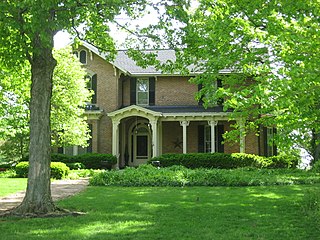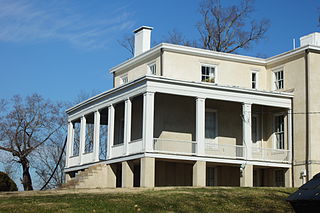
Berkeley Plantation, one of the first plantations in America, comprises about 1,000 acres (400 ha) on the banks of the James River on State Route 5 in Charles City County, Virginia. Berkeley Plantation was originally called Berkeley Hundred, named after the Berkeley Company of England. In 1726, it became the home of the Harrison family of Virginia, after Benjamin Harrison IV located there and built one of the first three-story brick mansions in Virginia. It is the ancestral home of two presidents of the United States: William Henry Harrison, who was born there in 1773 and his grandson Benjamin Harrison. It is now a museum property, open to the public.

Maysville is a home rule-class city in Mason County, Kentucky, United States, and is the seat of Mason County. The population was 8,873 as of the 2020 census. Maysville is on the Ohio River, 66 miles (106 km) northeast of Lexington. It is the principal city of the Maysville Micropolitan Statistical Area, which comprises Mason County. Two bridges cross the Ohio from Maysville to Aberdeen, Ohio: the Simon Kenton Memorial Bridge built in 1931 and the William H. Harsha Bridge built in 2001.

Levi Coffin was an American Quaker, Republican, abolitionist, farmer, businessman and humanitarian. An active leader of the Underground Railroad in Indiana and Ohio, some unofficially called Coffin the "President of the Underground Railroad," estimating that three thousand fugitive slaves passed through his care. The Coffin home in Fountain City, Wayne County, Indiana, is a museum, sometimes called the Underground Railroad's "Grand Central Station".

Ulysses S. Grant National Historic Site is a 9.65-acre (3.91 ha) United States National Historic Site located 10 mi (16 km) southwest of downtown St. Louis, Missouri, within the municipality of Grantwood Village, Missouri. The site, also known as White Haven, commemorates the life, military career and presidency of Ulysses S. Grant. Five historic structures are preserved at the site, including the childhood home of Ulysses' wife, Julia Dent Grant.

Waveland State Historic Site, also known as the Joseph Bryan House, in Lexington, Kentucky is the site of a Greek Revival home and 10 acres now maintained and operated as part of the Kentucky state park system. It was the home of the Joseph Bryan family, their descendants and the people they enslaved in the nineteenth century. Bryan's father William had befriended Daniel Boone and they migrated west through the Cumberland Gap.

The River Croco is a small river in Cheshire in England. It starts as lowland field drainage west of Congleton, flows along the south edge of Holmes Chapel, and joins the River Dane at Middlewich. It is about 8 miles (13 km) long.

The Zachary Taylor House, also known as Springfield, was the boyhood home of the 12th president of the United States, Zachary Taylor. Located in what is now a residential area of Louisville, Kentucky, Taylor lived there from 1785 to 1808, held his marriage there in 1810, and returned there periodically the rest of his life.

Riverside, The Farnsley–Moremen Landing is a historic 300-acre (120 ha) farm and house in south end Louisville, Kentucky, along the banks of the Ohio River. The house is a red brick I-house with a two-story Greek Revival.

The Coffin House is a National Historic Landmark located in the present-day town of Fountain City in Wayne County, Indiana. The two-story, eight room, brick home was constructed circa 1838–39 in the Federal style. The Coffin home became known as the "Grand Central Station" of the Underground Railroad because of its location where three of the escape routes to the North converged and the number of fleeing slaves who passed through it.

Greenwood Farm is a historic property and nature reserve located in Ipswich, Massachusetts, and owned by The Trustees of Reservations. The farm is 216 acres of gardens, pastures, meadows, woodlands and salt marsh and it features the PaineHouse, a First Period farmhouse constructed in 1694.
The Dean Family Farm, listed since 1975 as a historic site on the National Register of Historic Places, has its origins with the immigration of Daniel Dean, a native of Tobermore, County Londonderry, Ireland, to Philadelphia, Pennsylvania, in 1784 when he was aged 18, according to Dean family histories. Daniel was a son of George Roger Dean, who fought in the Colonial line, and Mary Campbell who was reared with her sister by the Duke of Argyl at Inveraray Scotland, the clan Campbells' ancestral home.

The John Johnson farm is a historic home and listing on the National Register of Historic Places in Hiram Township, just west of the village of Hiram, Ohio, United States. The home, built in 1828, is a significant location in the history of the Latter Day Saint movement as the home of Joseph Smith and his family from September 1831 to March 1832. While Smith lived at the home, it served as the headquarters of the Church of Christ and was the site of several revelations to Smith and other Church leaders. The Johnson Farm is also significant as the site of the tarring and feathering of Joseph Smith and Sidney Rigdon in March 1832.

Ridgedale is a 19th-century Greek Revival plantation house and farm on a plateau overlooking the South Branch Potomac River north of Romney, West Virginia, United States. The populated area adjacent to Washington Bottom Farm is known as Ridgedale. The farm is connected to West Virginia Route 28 via Washington Bottom Road.

The western part of Virginia which became West Virginia was settled in two directions, north to south from Pennsylvania, Maryland and New Jersey and from east to west from eastern Virginia and North Carolina. The earliest arrival of enslaved people was in the counties of the Shenandoah Valley, where prominent Virginia families built houses and plantations. The earliest recorded slave presence was about 1748 in Hampshire County on the estate of Thomas Fairfax, 6th Lord Fairfax of Cameron, which included 150 enslaved people. By the early 19th century, slavery had spread to the Ohio River up to the northern panhandle.

The James and Sophia Clemens Farmstead is a historic farm situated in western Darke County, Ohio, United States. Located at 467 Stingley Road, approximately 1 mile (1.6 km) from the Indiana border, it is among the oldest remaining buildings of a small community of free African-Americans founded before the Civil War.

Elmwood Place is a historic farmstead in the southwestern corner of Union County, Ohio, United States. Located along State Route 161 near the community of Irwin, the farmstead comprises six different buildings spread out over an area of 9 acres (3.6 ha).
The Elisha Sharp House is a house in Ten Mile, Tennessee. It was added to the National Register of Historic Places on July 6, 1982.

Elk Hill, also known as Harrison's Elk Hill, is a historic plantation home located near Goochland, Goochland County, Virginia. It was built between 1835 and 1839, and is a 2+1⁄2-story, three-bay, stuccoed brick central-hall-plan house in the Greek Revival style. It has a two-story rear ell. The front facade features a one-story Tuscan order portico consisting of paired rectangular wooden pillars supporting a full entablature. Also on the property are the contributing servants' quarters, tack house, and spring house. It was listed on the National Register of Historic Places in 1979.

The Judge Sebron G. Sneed House is a historic former limestone plantation house in Austin, Texas, commissioned by Judge Sebron Graham Sneed. It was likely designed by architect and general contractor, Abner Hugh Cook, co-owner of the sawmill where Sneed had purchased lumber for the construction of the house. Cook is most notable for designing the Texas Governor's Mansion in Austin.

Spring Hill is a historic home museum in Massillon, Ohio. The estate was settled and started by Thomas and Charity Rotch, and it was eventually owned by the Wales family for three generations. Spring Hill is recognized on the National Park Service Underground Railroad Network to Freedom. The estate encompasses the main house and several outbuildings, including a smokehouse, spring house, milk house, and wool house




















